It´s a pitch black night. As the sky is completely overcast, there´s no moonlight. The Bay of Biscay is dark. Only a pale red light from the dimmed chart plotters and the – a bit enervating – non-dimmable compass light makes for a visual focal point for our eyes. It´s the first ever night watch for Finn, my watch mate, as we are sailing through the Bay of Biscay. He does not seem to be scared, but this occasion is certainly not the most comfortable situation for the young sailor. SOSIMA has left Les Sables d´Olonne a few hours ago after three intense days of handover (you may read parts 1 and 2 if you haven´t already) with a nice 12 to 15 knots wind.
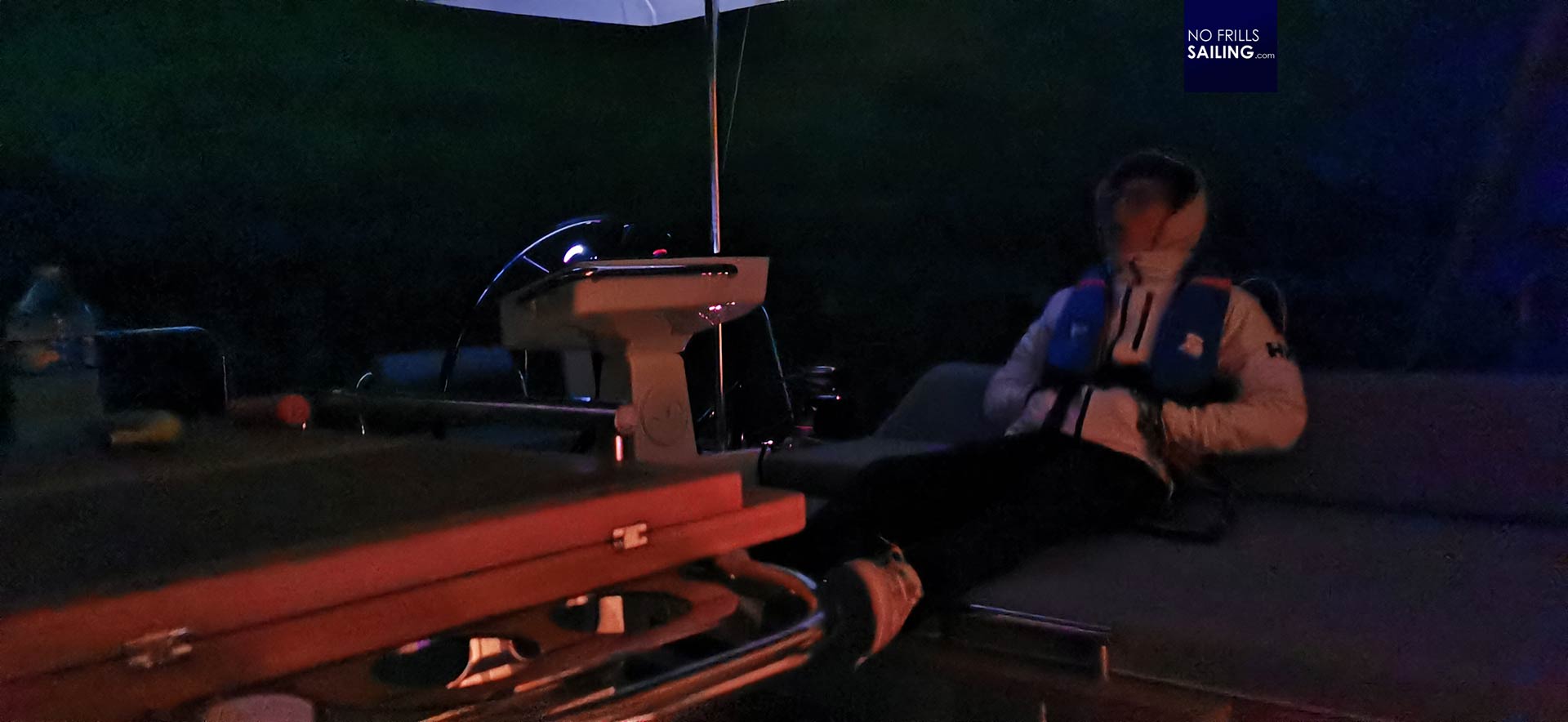
We are still on full canvas out. The boat is sprinting along on an upwind point of sail, making a good pace with 7.5 to 8.5 knots, depending on the incoming waves. It may have been a risky decision to cast off right away. The past days of handover had been very stressful for all of us: For the new owners most certainly because we´ve pumped up their brains to the brim with all those information, for me and the Beneteau guys because it´s a pedagogical balancing act to meter the level and intensity of handover. Getting the ship ready with provisions, safety equipment and sorting all things out in a matter of a few hours was pure stress. Maybe it would have been smart to allow us all a full night of restorative sleep. Maybe. Certainly. But here we are now: Dashing away from the French coast into the pitch black night.
Westward, ho! Through the Bay of Biscay
Of course, Finn, the youngest of the owner´s family brothers, and me tackle this first night watch. Four hours of constantly checking the AIS-surroundings, sails trim and weather. For me a routine, although the last time I went sailing overnight is (sadly) a bit long time ago. After being relieved I just fall into my cozy bed. The boat is moving gently through the waves, even upwind with an increasingly building seastate, so that it does not take long until I really fall asleep.
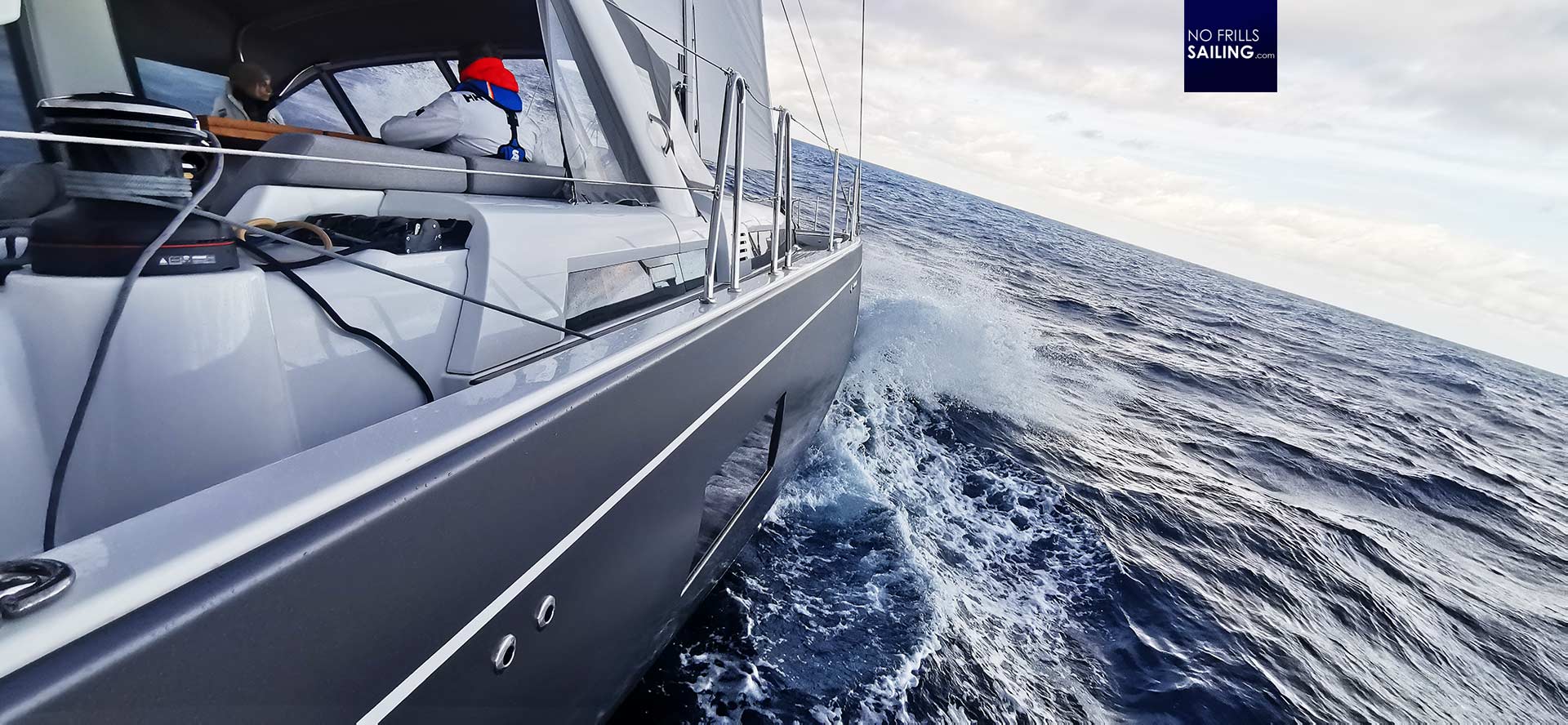
After two or three hours, sun is up and a I can spot a beautiful sunny day through the large hull windows of my aft cabin, I brush my teeth and get on the deck. The owner and his other son, Jesper, are at the helm. Waves have increased as did the wind speed. We are still close hauled on a strict upwind point of sail, course some 250 degrees, much higher than you would need to cross the Gulf of Biscay. The reason is of course the weather. Our sailing strategy needs to be panned 3 days ahead, reacting to the latest forecast. The problem: Atlantic Ocean weather patterns are pretty dynamic and forecasts become very uncertain over 24 hours. Our last internet contact is some 24 hours away, so the forecast may have stayed the same – or may have changed.

In this, the idea is to follow close hauled sailing until roughly the middle of the Biscay. Then, a west-shift of the wind is expected with a sudden drop of wind speed up until a full blown calm. Then we´d use the engine until a new wind field is coming in, first a westerly turning into a north-wind which, hopefully, would blow us around the Cape Finisterre. Right now SOSIMA is dashing through the waves, ever more violently rocking when cutting through the waves, at an impressive speed. What really amazes me is that there is honestly no slamming into waves (only very rarely when a wave comes in “strange”). A sign for a very, very well designed underwater shape of this hull.
Betting on the wind
After a few more hours, right after noon, the wind died down completely. We take in all sails and start the Diesel engine. Which is always a burden for any keen sailor, foreshadowing boring hours of constant noise, Diesel fumes and enervating motion of the boat in the swell. But I see it as a good sign: The forecast which is now more than one day old seems to be valid still. As the calm occurred as predicted, the chances are high that another 9 to 11 hours later the forecast will still be correct with wind picking us up again. For now, all we can do is to endure the boring engine sound and focus on … well, enjoying the sun, maybe?
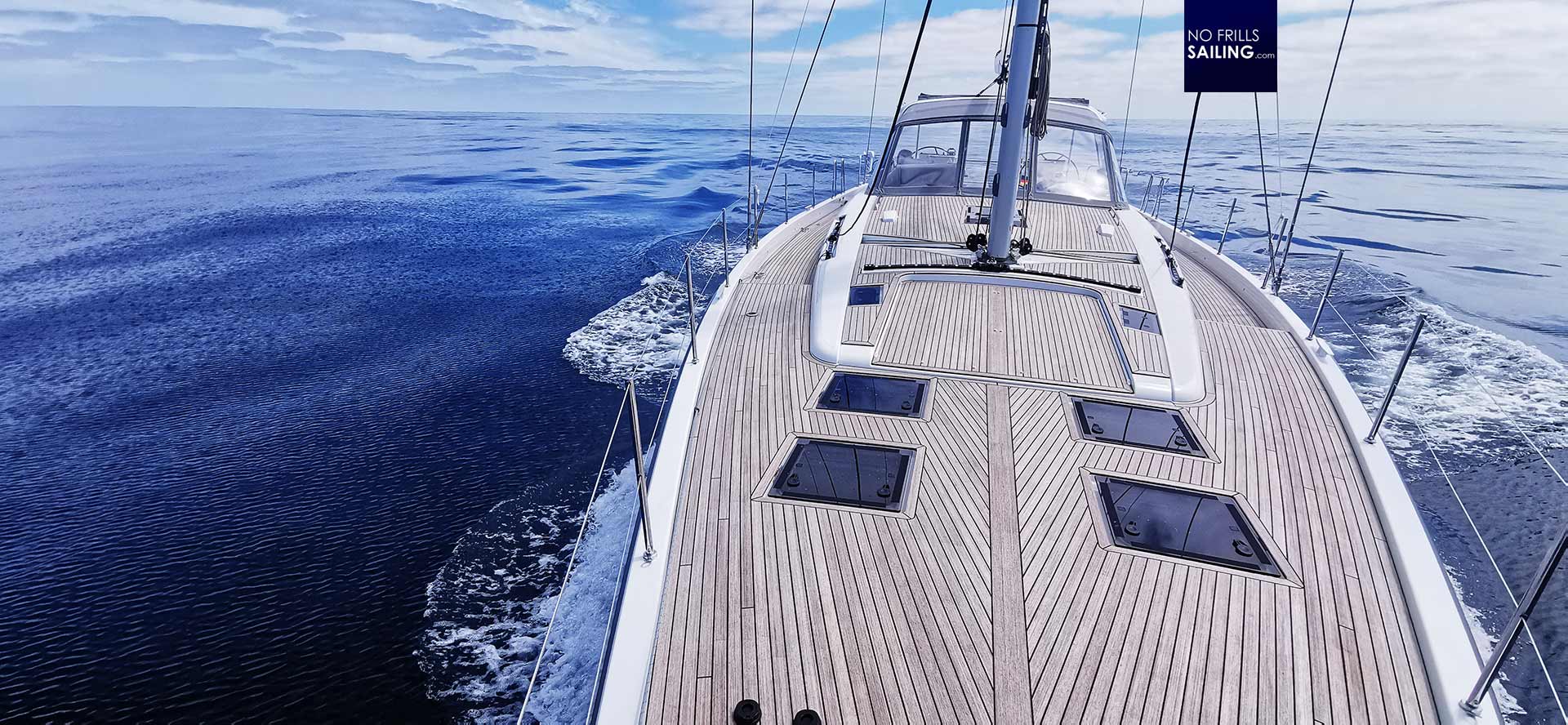
SOSIMA is visited frequently by Dolphins during the day which is a big thing for our owner-family. Videos taken, pictures shot. But even the schools of them cute keen predators of the oceans seem to be bored somehow by the weather: No jumping, no playing. They just pass by crossing our due course, no real interaction. We also spot the fountains of whales exhaling in some 200 meters distance, occasionally their huge bodies come out of the water, exposing a small fluke: Probably Baleen whales. Other than that and a nice hot meal for lunch/dinner, nothing happens until the sun went down. Up again after some rest for a few hours, I do my next 4 hour watch. As expected, wind is back, but blowing from a more westerly direction. I have to change course to 200, 190 degrees – not good!

As I went down, it´s pitch dark again, for my next off-watch, wind has picked up significantly. The boat is still close-hauled, partially reefed. Dashing along with 7.5 to 8.5 knots, it´s the southbound course that increasingly worries me. If the north-shift won´t occur, we won´t make it to Finisterre and probably would have to go to Gijon to wait for a better weather window. As I knew that after tomorrow a strong Southerly blowing up North – directly into our face – will make going south becoming an ordeal, we urgently need this north-shift to round the Cape before it will be rendered impassable after tomorrow. I go t bed with a very unpleasant feeling …
Family sailing
I wake up. It´s bright daylight. Rocking motion of the boat increased, we are sailing (a good sign) and I can clearly hear the loud roar and hollering of the wind. Are we still southbound, maybe for Gijon? This would mean a major blow to our plans. Minimum 3 to 5 days wasted until the next favorable weather window would be opening up. I gear up. Take the first steps up to the cockpit, eagerly peering to the faces of the watch: Smiling or lamenting? They smile! “The shift! It came – by the minute! 5 degrees north-shift every 5 minutes!”, both are yelling and laughing, relieved that we are now on a westerly course again for the Cape Finisterre. Are we lucky? Yes, we are indeed!
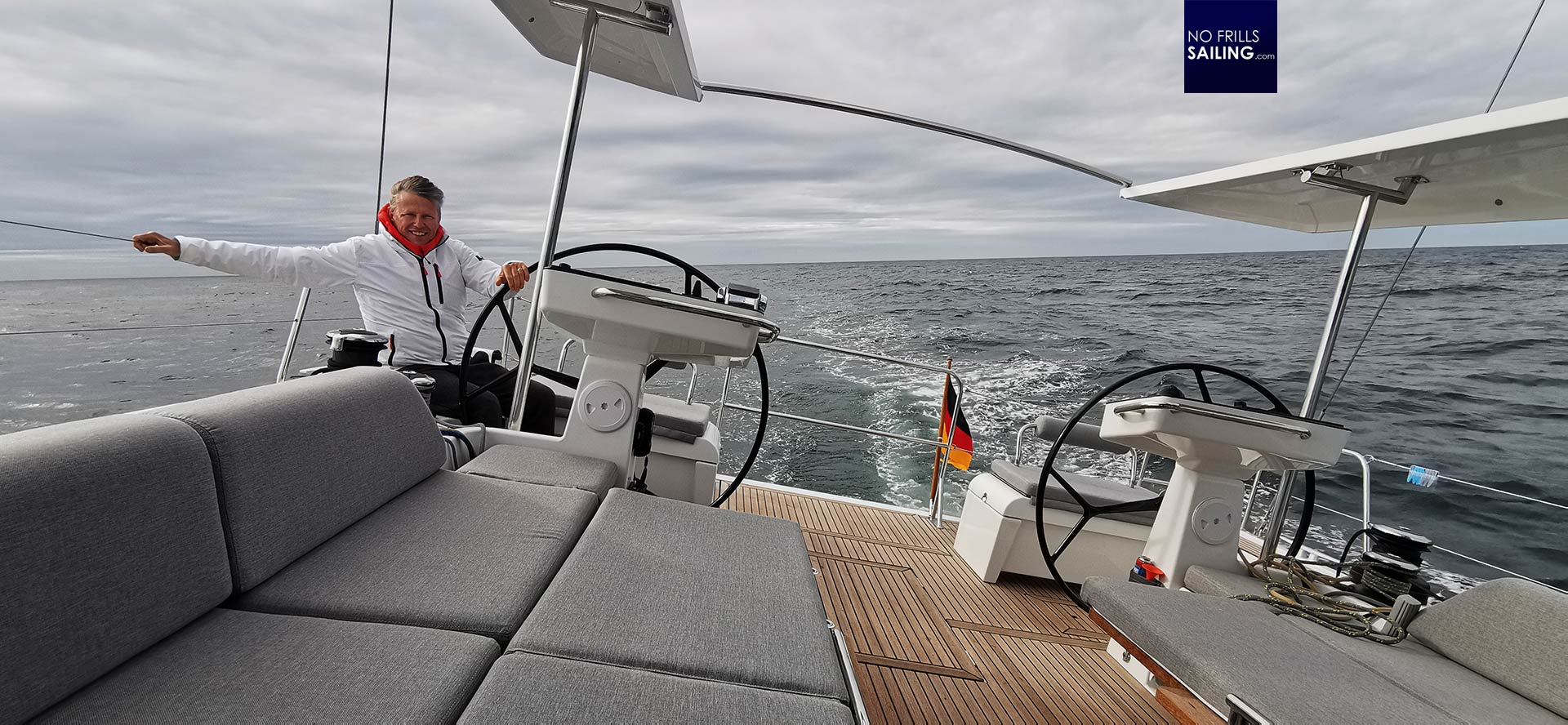
Hour by hour SOSIMA makes her way to the famous Cape, the north-western corner point of Spain, the Iberian Peninsula. Had the wind been blowing very strong when I started my shift, it continued to lose power every hour so that we are back on full canvas around noon. It´s time for some serious leisure cruising again. This is one nice detail about the Oceanis Yacht 60: There are two cockpit tables which can go up and down by pushing buttons. Also, the tabletops of those can be folded out to make either a big dining table or – in our case – with some extra cushions for a nice, big, cozy lounging area. The boys and the wife just love this place!
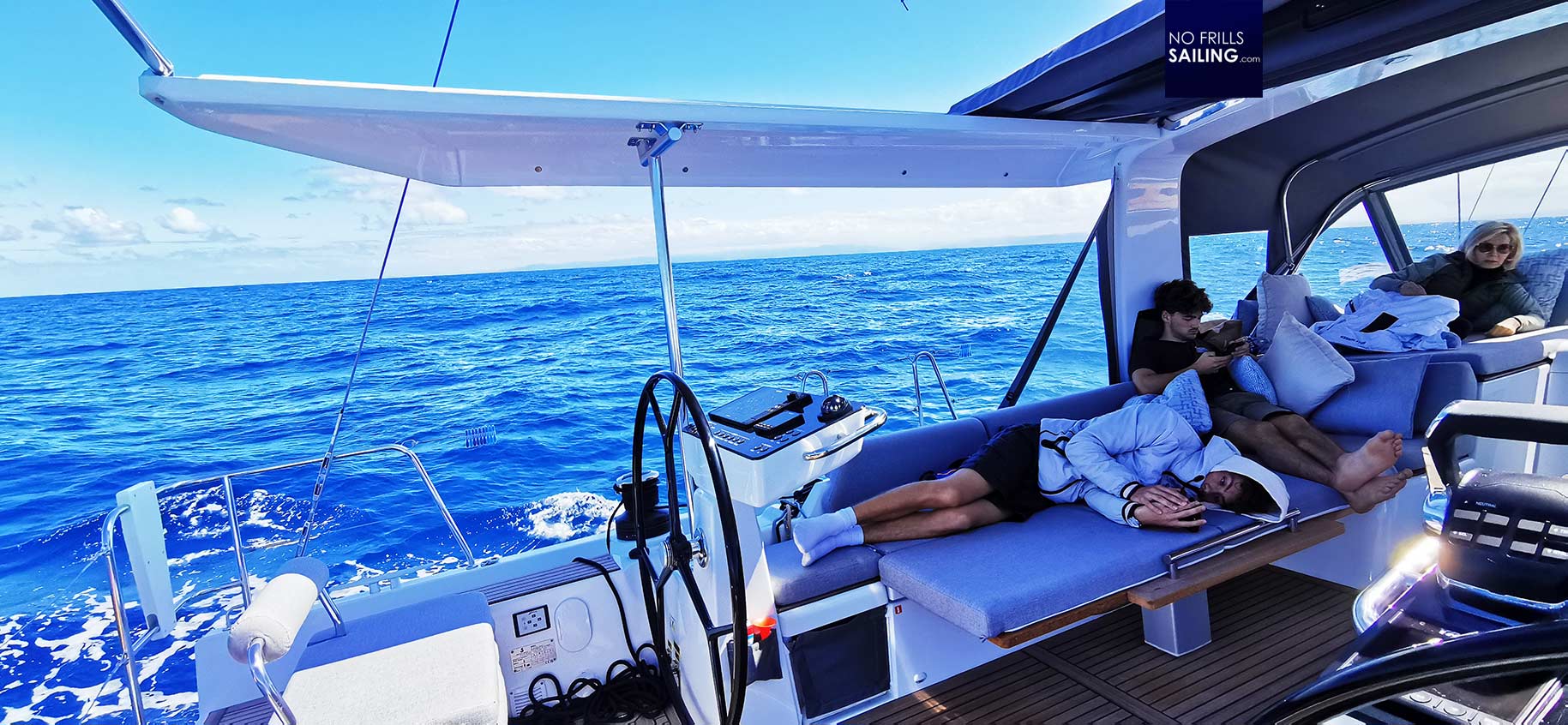
In our “family cruising-configuration” we have the lounge-area to leeward (for safety) and the table to windward side of the cockpit. In this set-up, the ones in off-watch mode can lay down, enjoy the sun (with Bimini top open or closed, depending on the sun and how much protection is desired) and us, being on watch, can sit down occasionally at the table, taking a drink, talk and look around. That´s one of the nice details about having a big boat like this. What I notice though is the ever growing fatigue among the crew. Even preparing a meal seems to be more and more stressful for us all. Well, it was time for a suggestion.
A Coruna!
Although I knew that if we didn´t round the Cape Finisterre this day and instead would opt for a sleepover to replenish some energy, we´d probably face unfavorable weather conditions once the Cape was rounded. Nevertheless, sailing on with a crew that has zero energy left posed an increasing risk of fatigue-related miscalculations, errors and possible catastrophe. So I proposed to have a sleepover in A Coruna which was “just around the corner”. They all agreed, the prospect of sleeping in a non-moving bed for longer than 4 hours was all-too tempting. Several hours later (lesson learned: “around the corner” in sailing means literally 6 hours to go), at around midnight, we had SOSIMA tied up in A Coruna. Without even connecting the shore power line, we sank into our beds, not awakening until 9 hours later …
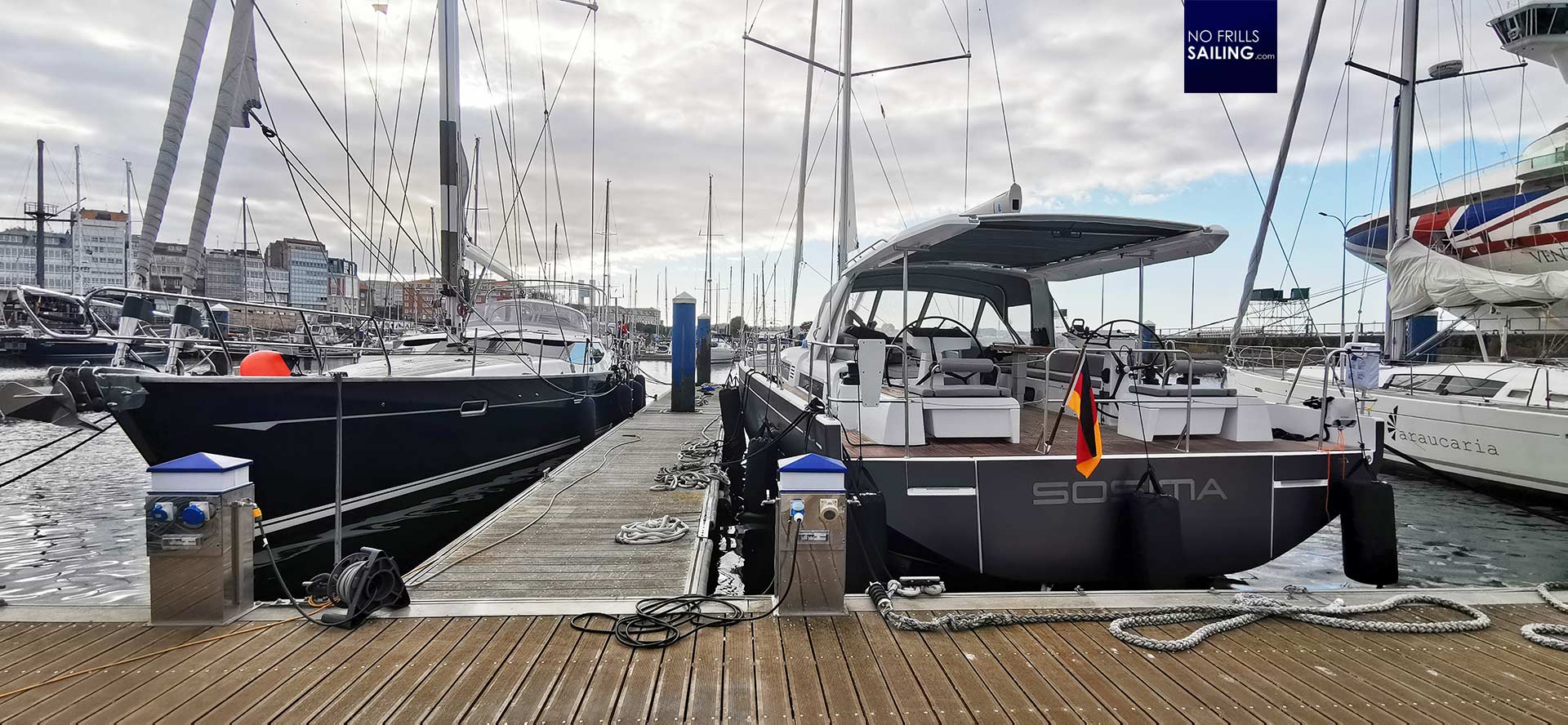
It was pure bliss. As the huge cruise liner had switched off one of its loud air conditioning units at around 3 a.m. I found a very, very deep good night´s sleep. Awakening a 8 o´clock in the morning, I checked the situation, grabbed my purse and went ashore to grab a strong Spanish coffee, which was pure bliss again. Strolling back to the boat, which by chance we had tied up next to a nice and classy Oyster 67, I noticed another strange thing: Size spoils.
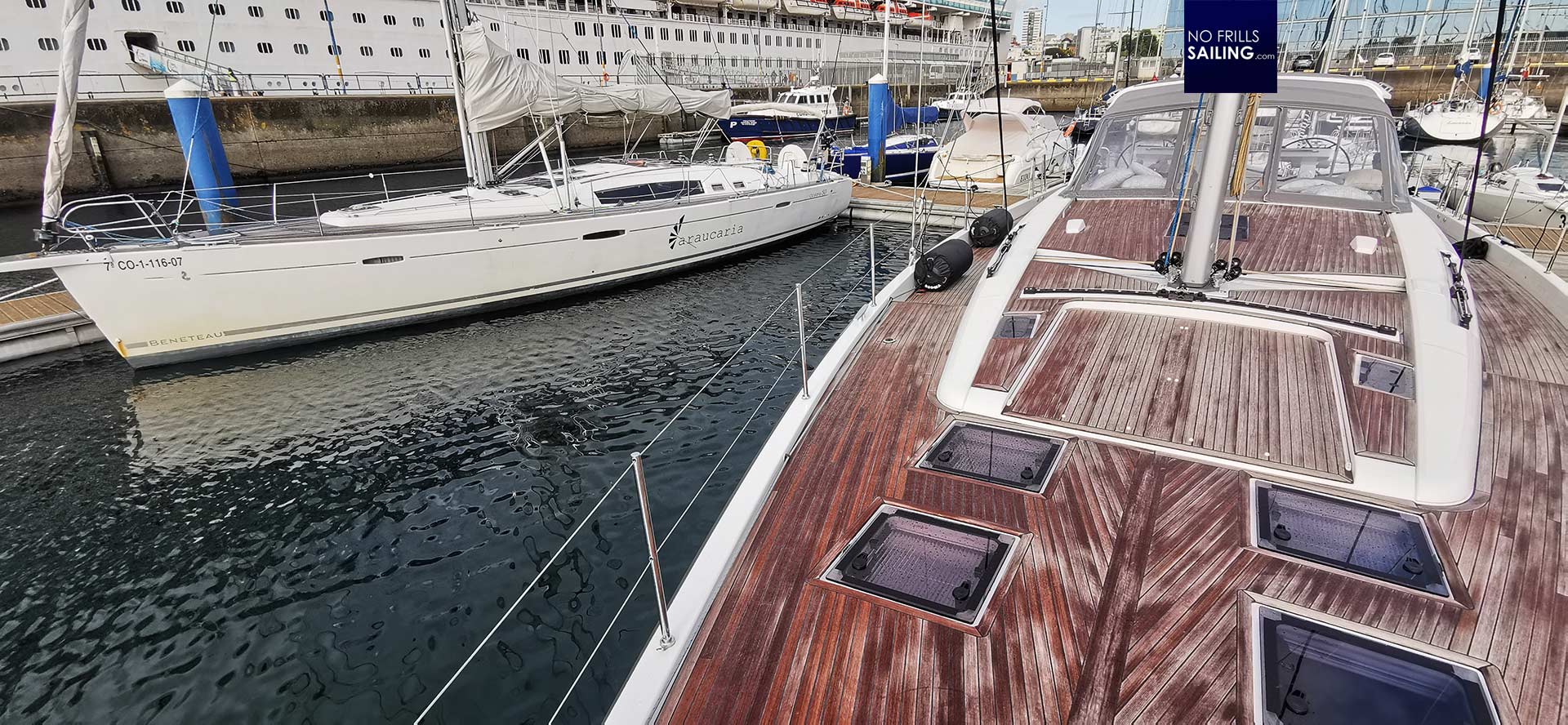
Standing on the bow of SOSIMA, the neighboring boat to our other side was a Beneteau 50. Just look at the picture above: The size difference may not sound very big, 50 to 60 feet. But those 3 meters more length mean much more in every direction. The volume and size-difference between a 50-footer and this 60 feet yacht is astonishing. And 50 feet, don´t get me wrong, is a damn big boat!Am I spoiled by the luxury of this boat? Yes, of course: It´s a huge increase in comfort, seakindness and amenities for sure. Staying grounded for that reason is imperative.
Hidden gem: Galicia´s coastline
A Coruna, to our regret, indeed just remained a calm sleepover. After a rich breakfast in one of the nice Cafés on the waterfront, we casted off again at around noon. Time was running out: The Northerly disappeared once and for all, replaced by a Southerly. That, of course, was the most undesirable wind direction we could imagine. Having to go down south against a prevailing headwind and an ever building seastate? Not funny!
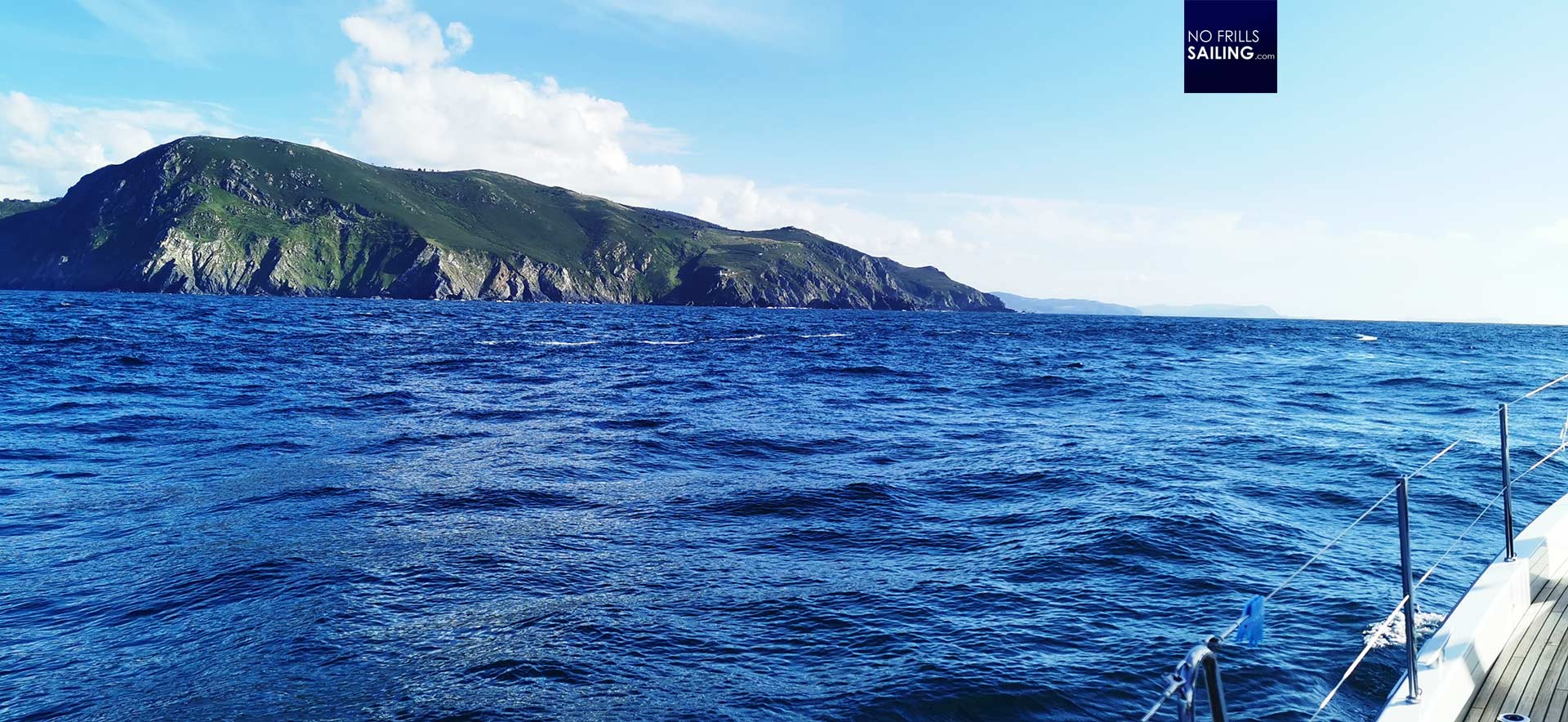
Anyway, as sun was shining and – still not around the corner – we had some rest wind to sail from, the day started very, very nicely. With full canvas up, SOSIMA sprinted through a deep blue water. I really admire the Galician coastline: Barren, rugged and rocky, broken up by caves, steep cliffs and nasty little boulders posing risks for collisions. But also green and lush, with occasional forests. “Costa da Muerte”, that´s the name of the area around Cape Finisterre, a very special place. Well know for the harsh conditions, sudden weather changes, currents and strong winds, sped up by the cape effect – a burial ground for thousands of seafaring souls, hundreds of ships.
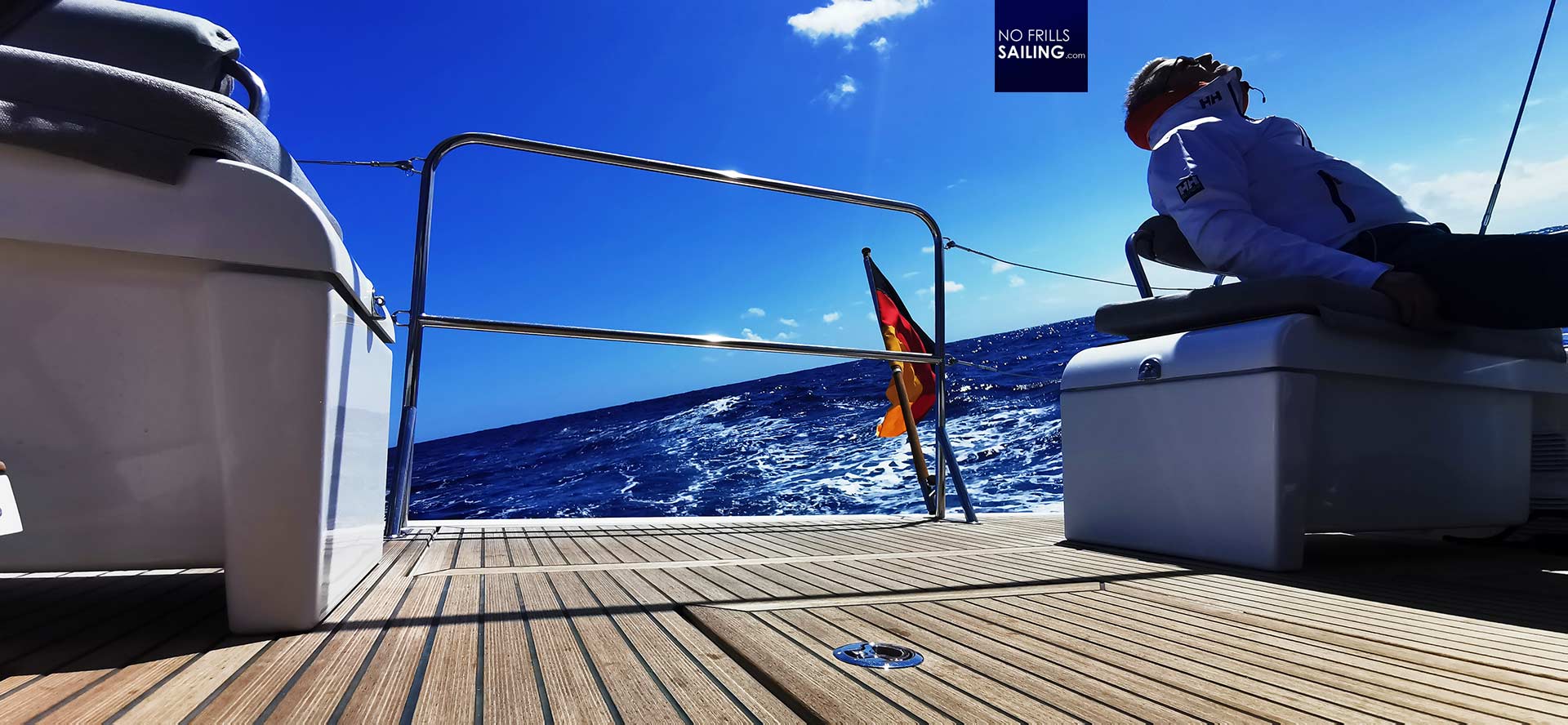
It´s some wonderful hours of sailing, many more than I´d have expected. We are sailing alongside a small flotilla of 8 to 10 boats. We will later meet them again: A rally for cruising boats, starting in Les Sables d´Olonne just a few days before we left with destination Baiona, which is one of the sister cities of Les Sables. What a nice occasion! We manage to overtake many of them, as we more and more round the notorious Costa da Muerte.
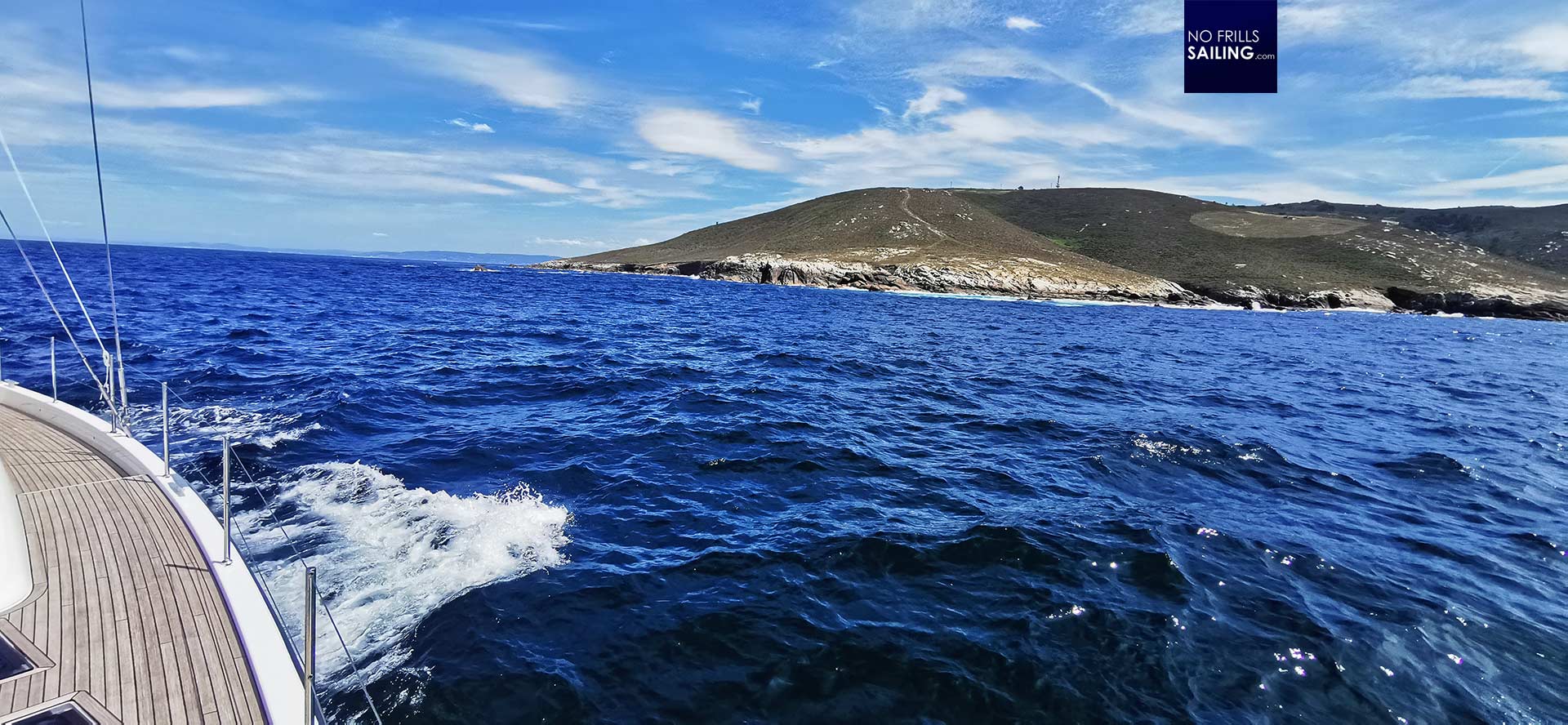
This area of Spain fascinates me. I´ve been here a couple of times before and kind of fell in love with Galicia. Often neglected by mainstream tourism as the weather is too unpredictable, beaches too rare and rocky, this landscape kind of remains one of Southern Europe´s last “untouched” resorts. In all of that, it´s a landscape abundant with rich nature, a rich culture and breathtaking scenery. Everytime I am here, I promise myself to one day return with much, much more time to use to fully embrace and discover Galicia. As we pass the beautiful, strange, empty, green and rocky landscape, sadly, wind direction becomes more and more undesirable by the minute now.
The crux with delivery sailing
That´s the thing with deliveries: It´s not a leisure sailing trip. You have to bring the boat from A to B, usually with a fixed date of arrival. Although I always suggest my clients to not book any return flights unless there are favorable flight change or cancellation policies, of course, nobody doesn´t have no appointments and unlimited free time at hand. Therefore, often the case with delivery cruising, you simply cannot choose to sail a detour – you take down the canvas, start your Diesel and steam right ahead dead into the wind. And that´s what we had to do.
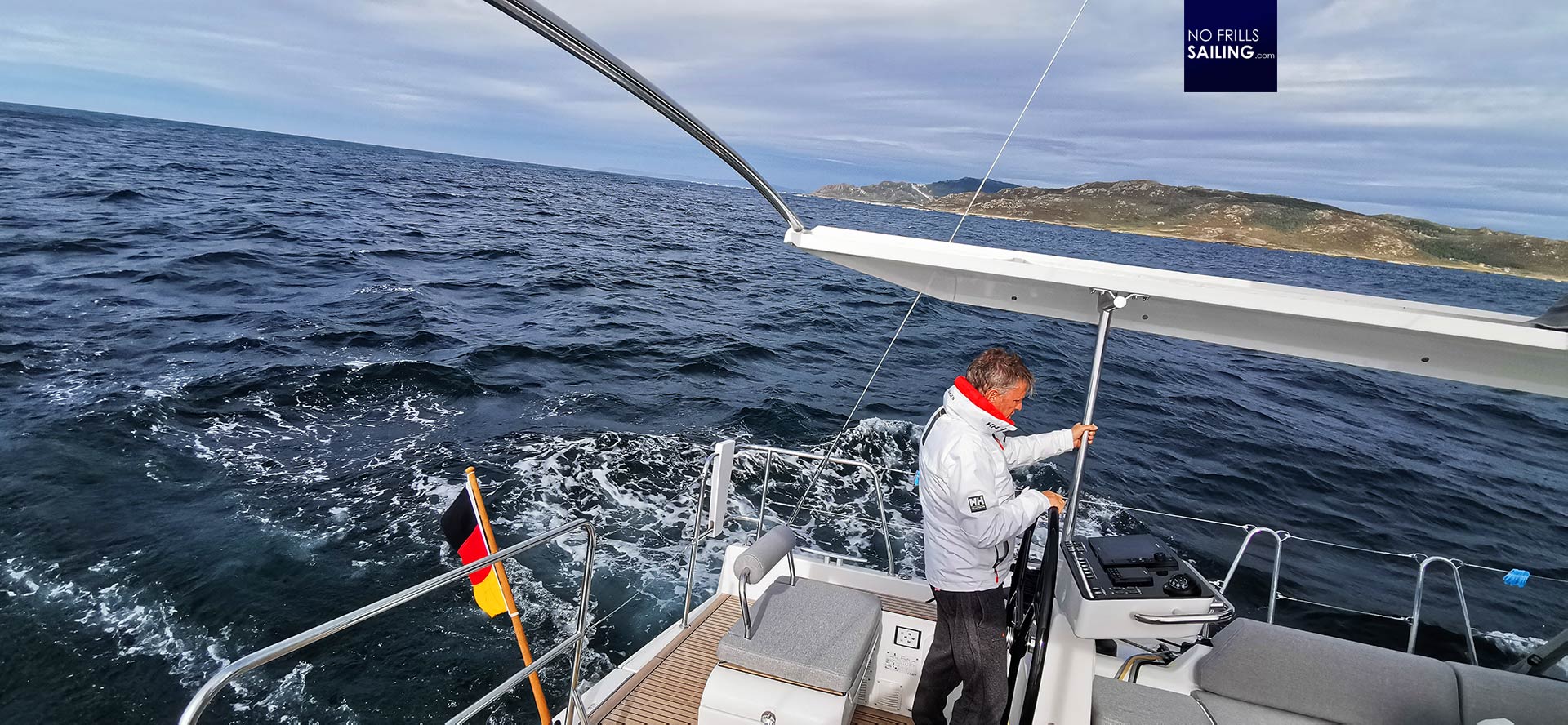
Our aim was to sail southwards, best would be Porto, minimum Baiona/Vigo. Now, with wind speed picking up very fast and weather conditions starting to deteriorate, I wasn´t that sure anymore. A last update on Windfinder.com confirmed my darkest anticipations: Southerly headwind to increase to 24 knots over the next hours. Once there, the northward blowing wind would remain there for at least two days. In a matter of two hours, the sky went from blue to overcast, temperatures dropped to sub 18 degrees Celsius, wind went up to 15, 18 and later 20 knots with waves becoming bigger and bigger. Time to react! There were only two options. First, put the boat to upwind sailing mode and sail head on tackling waves of 1.80 to 250 meters for literally two days, or, second, do what the Les Sables-Baiona-flottilla was doing: Reach for harbor.
Biscay tackled!
Which we did. After just “around the corner”, I recommended to seek shelter in Muxia. It´s a very little coastal town with a safe little marina, one which I´ve visited once before and really like it. First the owner was a bit reluctant – after “loosing” some hours while the Coruna-sleepover, he was now facing one or two days further delay in Muxia. But judging by the looks of his wife, who of course wasn´t so much in favor of hard upwind beating for days (especially through the scary night watches, he agreed and we pulled into Muxia harbor, where we were greeted very warmly by the harbor staff.
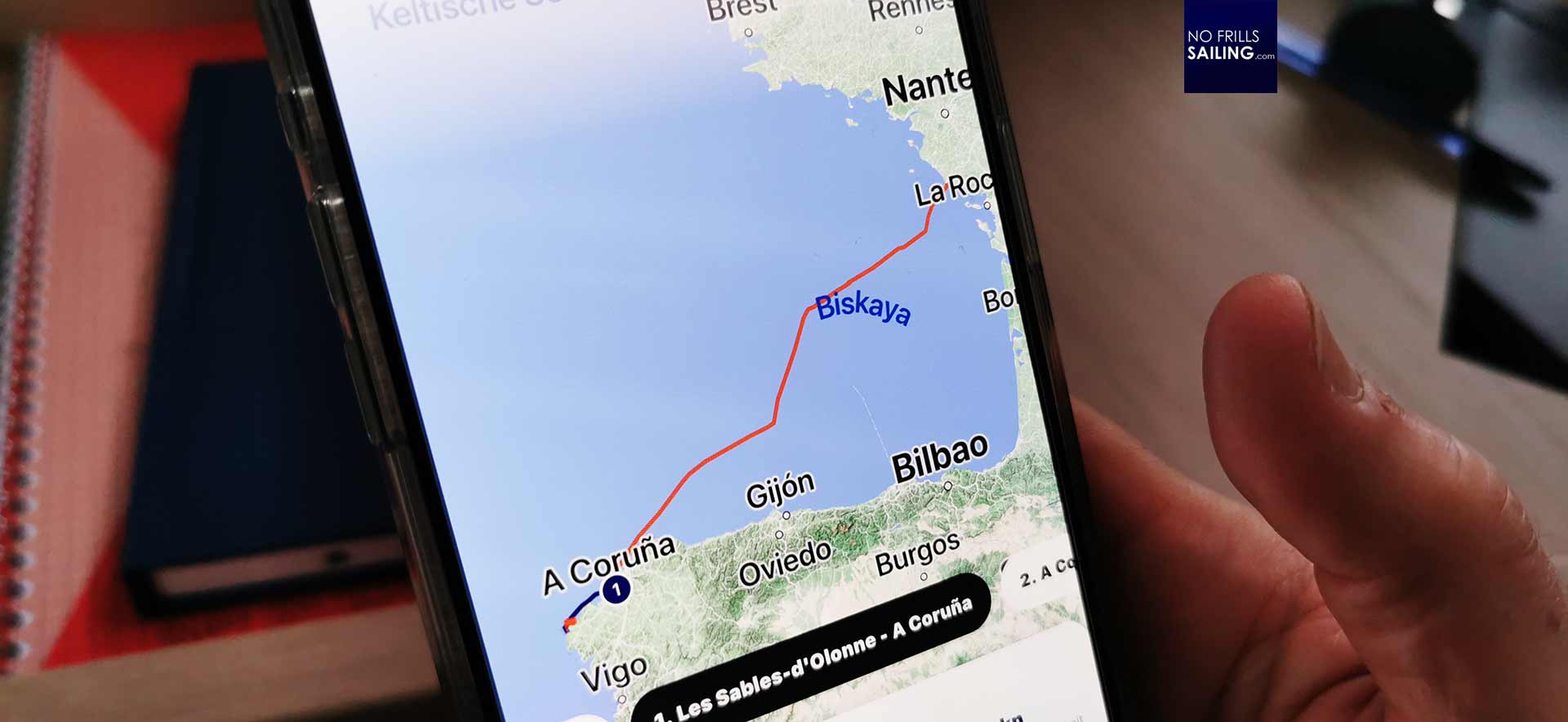
Well, in this, I´d say: We´ve tackled the notorious Bay of Biscay! What a nice occasion! Some 400 nautical miles since our early start in Les Sables some three days ago, SOSIMA and her crew did an amazing job. I mean, imagine taking over your first ever own boat and immediately face such a challenge, well done, guys! Well done! Most impressive, the boat managed to sail at 12.4 knots flank speed, according to our log. That´s absolutely amazing! Also, no matter if low wind or high wind speeds, she always sailed smoothly, conveying a sense of safety and serenity. A graceful yacht indeed.

We celebrated our Biscay-crossing with a big-time dinner. Huge Schnitzels fort he boys, freshest fish with grilled filets, fried Pulpo and tasty Pimientos de Padron filled our stomachs. Freshly drafted Estrella beers and some nice cold local Rosé wine rounded up a great evening celebration. It´s quite something for newcomers to take on such a challenge – where other prefer to pay tens of thousands of Euros to have their yachts brought by truck to the Med-destinations, this family took the chance to sail their new boat all the way round. Heads off to that!

We will stay in Muxia for two days. Weather deteriorates even more, conditions outside around Costa da Muerte become increasingly difficult. With a wind blowing at 22-26 knots for days, wave height outside is beyond bearable when going south. It´s raining all day long with occasional hours of no precipitation. The crew restocks some provisions in the one and only supermarket, does some cloth washing and test even more local food. I use the time to do some walking, once enjoying a breathtaking view over inshore Muxia harbor and the wild Atlantic. As I said: It´s worth taking some time staying here to discover the richness of those Rias of Galicia, for sure! Nevertheless, at the third day, wind dropped significantly (not direction, but anyway) and we decided to eventually cast off our lines again – time to head further south.
A moment of shock
The idea was to sail out on a straight westward course – due 270 degrees – fully reefed. Some 10 to 15 miles away from the shore, just before the traffic separation scheme around Cape Finisterre, wind was expected to be much lower. So, at least in theory, we could put in a southerly course and sail close hauled towards Porto. Just as we had left Muxia, taken out the sails and stopped the engine, some 10 minutes later we noticed a very familiar stench: Rubber! I dashed down to the engine compartment and it stunk very, very strongly. I also noticed a very familiar noise: The prop-shaft was turning the engine. So, apparently, automatic decoupling and folding of the prop did not happen. By turning the engine and the gearbox, something wasn´t greased sufficiently anymore and such created this stench. Multiple times starting/killing of the engine did not work at all, so, in fear to lose engine power (which would be absolutely catastrophic here at Costa Da Muerte) we decided to go back to Muxia. I frantically phoned everyone I knew deemed competent to give a hint … shit, shit, shit!

Facing another day (or more) in Muxia, general mood was noticeably down. After some feedback from the shipyard, we ran the engine at a significantly higher throttle. The idea was to increase oil pressure since the automatic de-coupling was directly connected to this. Shortly before reaching Muxia harbor, we gave it a last try. And see, rejoice, it worked! Having lost 3 hours for this matter, we finally sailed out on a westerly course, fully reefed, into the foggy, rainy Atlantic Ocean.
Headwind sailing strategy
Looking at those pictures, generally at all pictures, I always wonder how our high-tech cameras consistently refuse to take pictures which really show the sea state. No matter how high the waves and how intense the storm – later on, looking at the pictures, it always looks as if there was nothing! Amazing. But believe me, we encountered very harsh conditions, sailing fully reefed on our 270 degrees course. For many hours due West to sail away from the shore where – due to the Cape-effect – the wind was much stornger than further out.
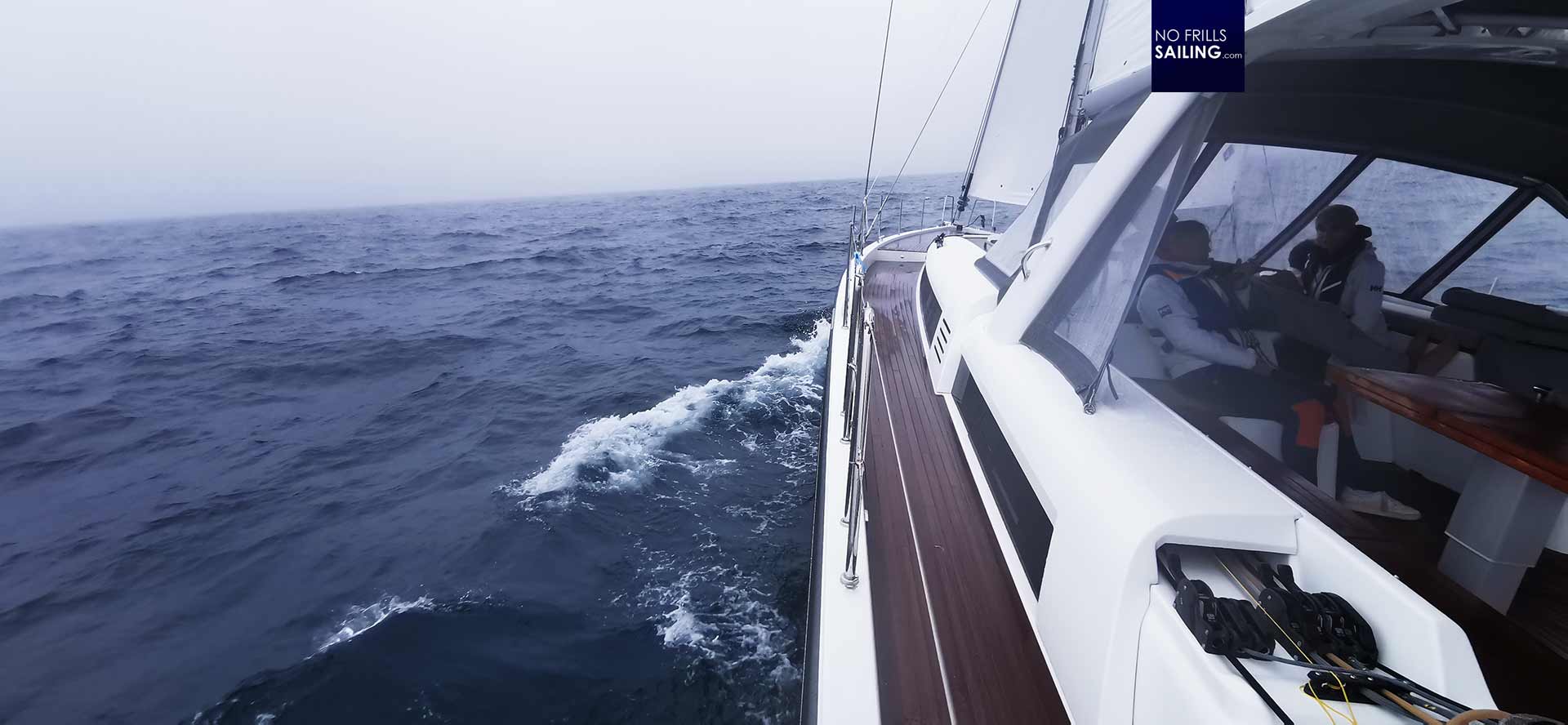
As predicted, slowly and by the hours, wind speed went down from mid-20ies to 18, 16 and finally 14 knots TWS. Waves became longer and less steep. As we were shortly before touching the TSS around Cape Finisterre, we deemed it right to finally change course due South, eventually bringing us nearer to Porto. Losing three hours for the decoupler-thing and now some three hours more sailing into calmer waters meant we´ve lost half a day and did not make a single mile south. A bit frustrating, though …
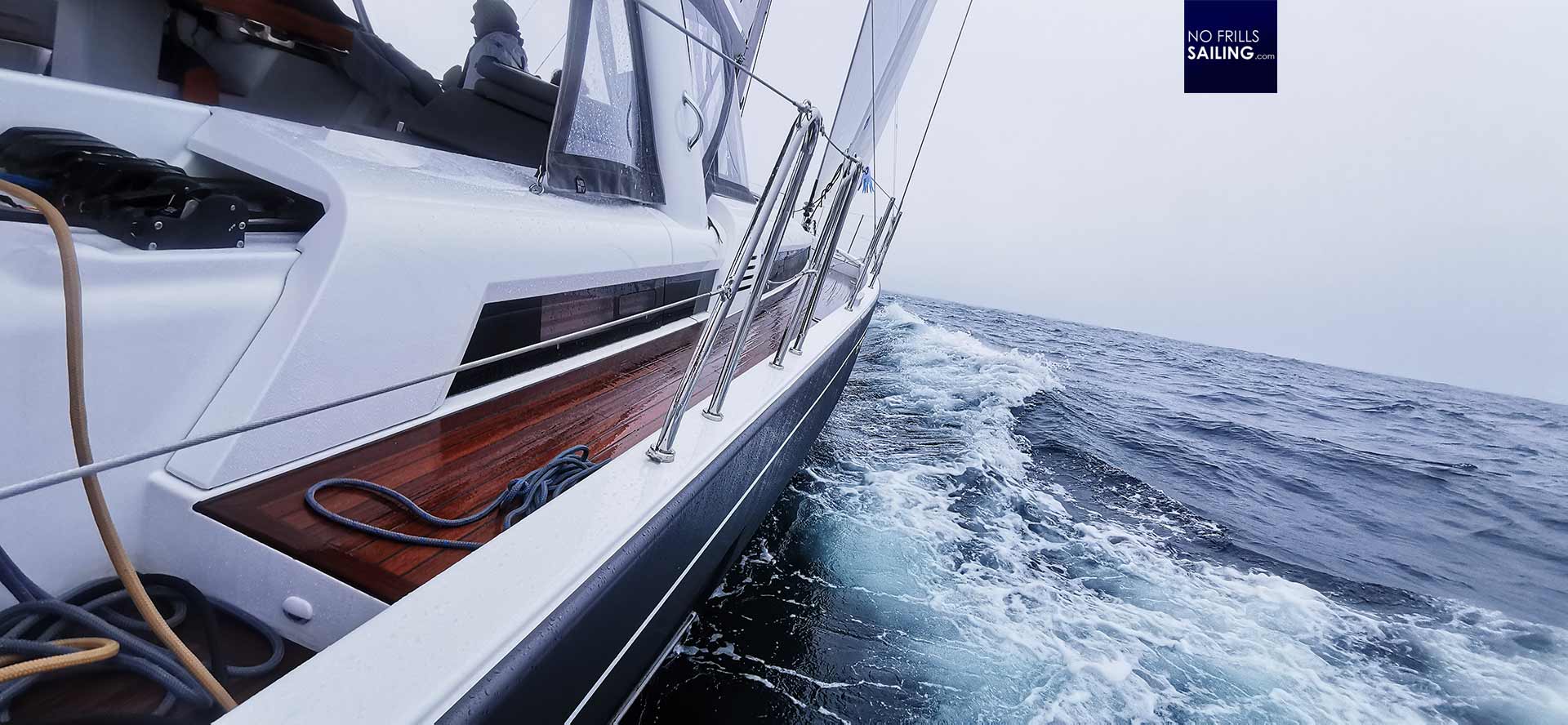
Nevertheless, the plan worked: We were sailing. Since it is most frustrating (at least for me personally) when you are using the engine on a sailboat, at least this way we could use our sails. Apart from that, mood was a bit ow amongst SOSIMA´s crew. No wonder, have we lost 2 days in Muxia and on top had to sit it through in cold spray rain – now, weather was even worse. “Where is this summer?!?”, was a question most frequently asked on that day, every time anyone came on deck to check, shaking their heads in disbelief, going down below to seek some sleep at least. But we´ve had also some nice moments.
Whales!
Up in the Biscay it was a big highlight seeing the spray of the fountains of some whales in the distance. I´ve never ever seen anything bigger than dolphins, so witnessing a small school of whales was a highlight, definitely. But on that day, something even bigger happened: Three – most likely – Baleen whales surfaced right next to our boat. And I mean literally right next to our boat!
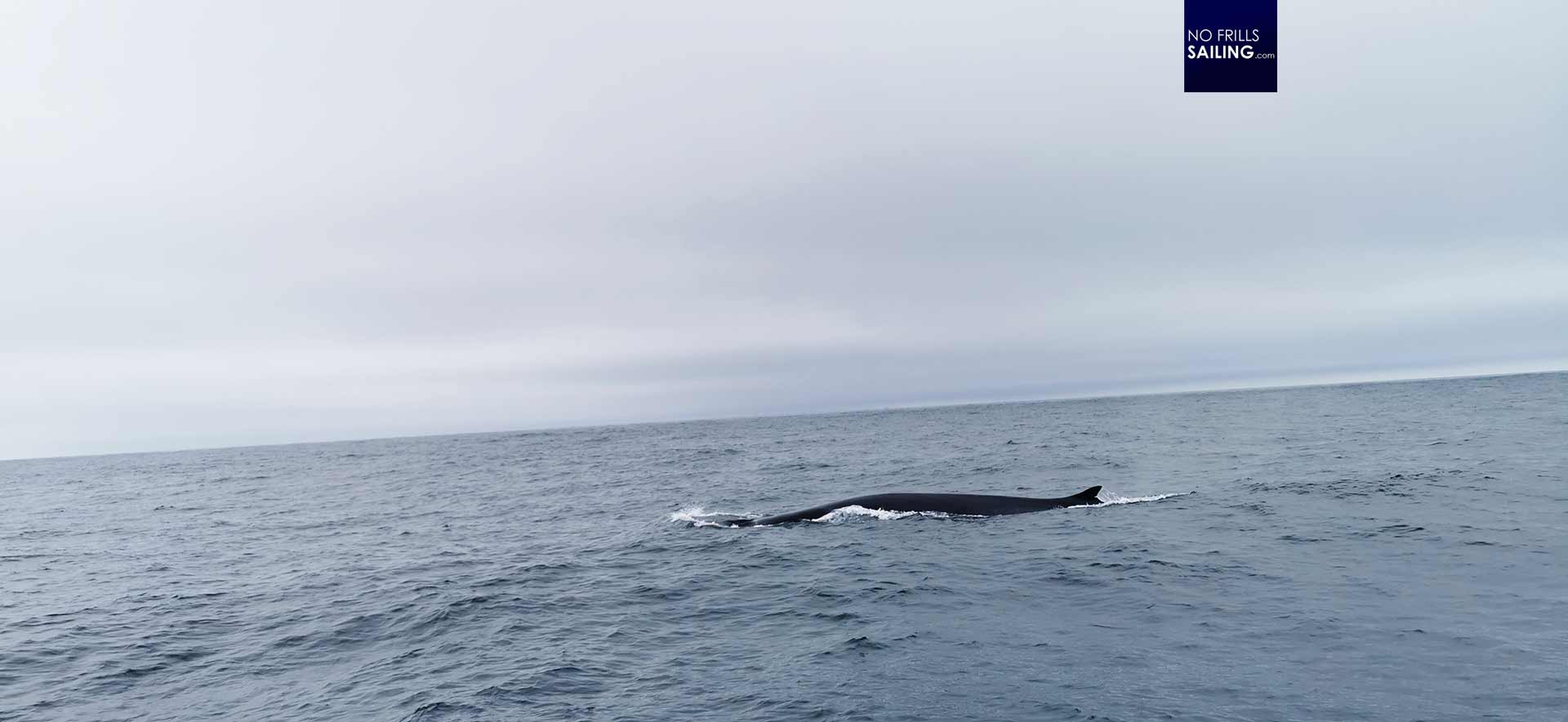
The animals had been almost as long as our boat, so minimum 15 meters, maybe even longer. Gracefully, without any struggle, they kept the pace with the yacht (of around 6 to 7.5 knots), frequently exposing their long backs and the small top fin. One was swimming right in front of our bow so that I sprung to the wheel and had my finger on the auto pilot controls, ready to react. Another one came to surface no five meters to our starboard side, opened his blowhole and breathed. A huge fountain shot in the air, a deep groaning sound. Breathtaking, literally.

The whole family was exhilarated and excited, jumping to the bow to shoot pictures and videos. Ever time a whale came to resurface next to us, a big “hello!” and “wow!” hollered into the fog. It is amazing how profound and deeply touching such an encounter is – the more incomprehensible the fact that – still! – humans are hunting down, killing and devouring those gracious mammals. This clearly was one of the true highlight of this sailing trip, for the family as well as for me personally, seeing free living wild whales roaming the waters. Something touching, deeply moving.
Final spurt to Porto
As time went past, the whales long gone, wind died down as predicted and returned to an unsailable 8 to 10 knots TWS. Wind direction shifted as well, now directly from where we wanted to go. Sails in, engine engaged – the boring part. I chose a course that put us slightly angled to the wave pattern so that we wouldn´t hit the waves 90 degrees head-on. Weather was rainy and foggy, still – I send a silent prayer to Poseidon to send us a clear sky and end the rain.
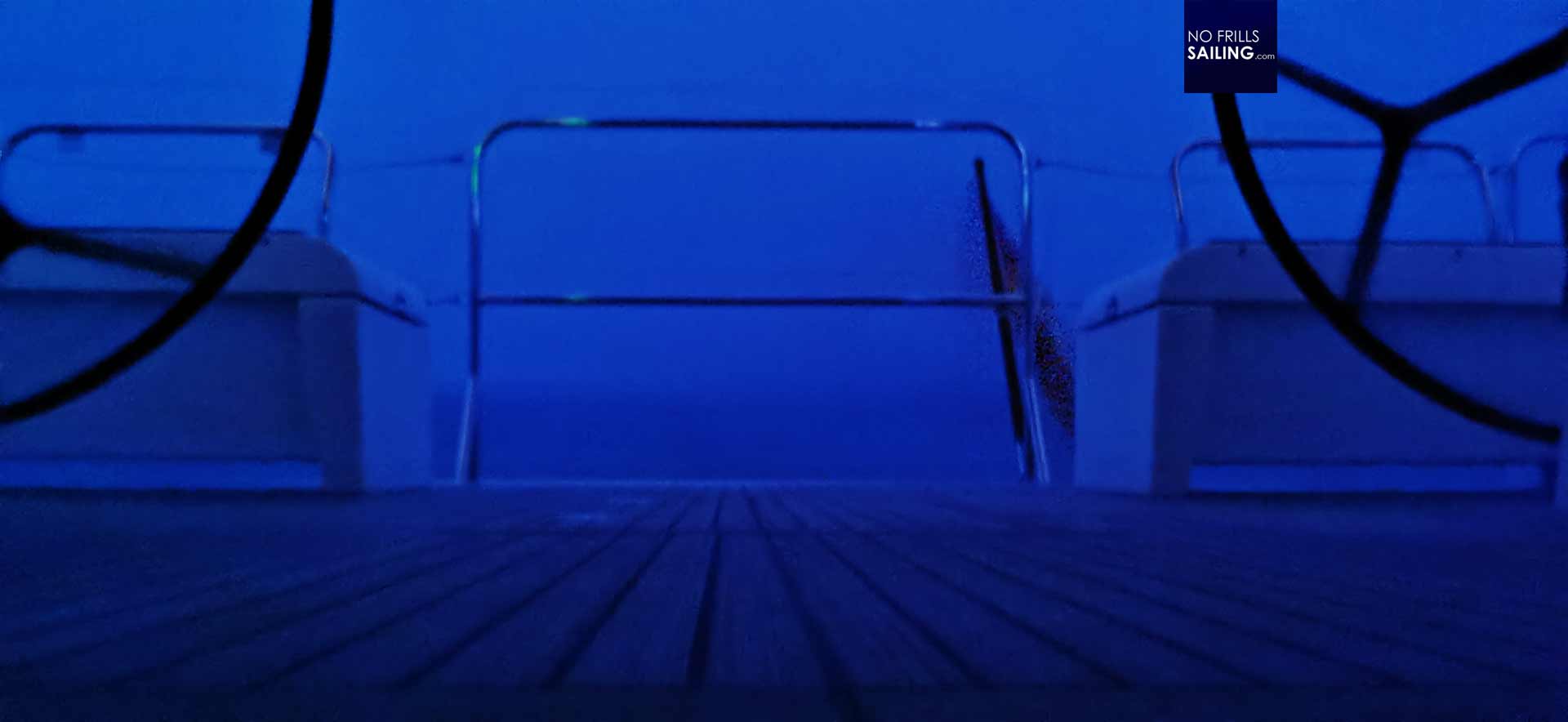
Returning up on deck to take on my last night watch, nothing had changed. Still headwind, still cold spray rain (of the type that creeps into every corner underneath your oilskin, disgusting!) and still some nasty short, choppy waves coming right at our bow. Some 35 miles to go to Porto, which was the best news of the day: Only 4.5 hours to endure this boredom.

Nevertheless, we´d had to be vigilant: Under 3 miles to the shoreline of Spain and later Portugal, there was some traffic of fishermen and small boats. During my last watch, all of them with position lights according to regulations, but we had to keep a thorough eye on their fishing buyos which came passing the boat frequently: Hitting the cables of one of those in the middle of the night, jamming our prop … well, that’s a horror vision! During the following watch of the owner, I sprinted on deck when he suddenly stopped the engine and changed course drastically: Apparently, two mid-sized fishermen without AIS suddenly switched on their lights right in front of us seeing/hearing us coming … a true moment of shock!
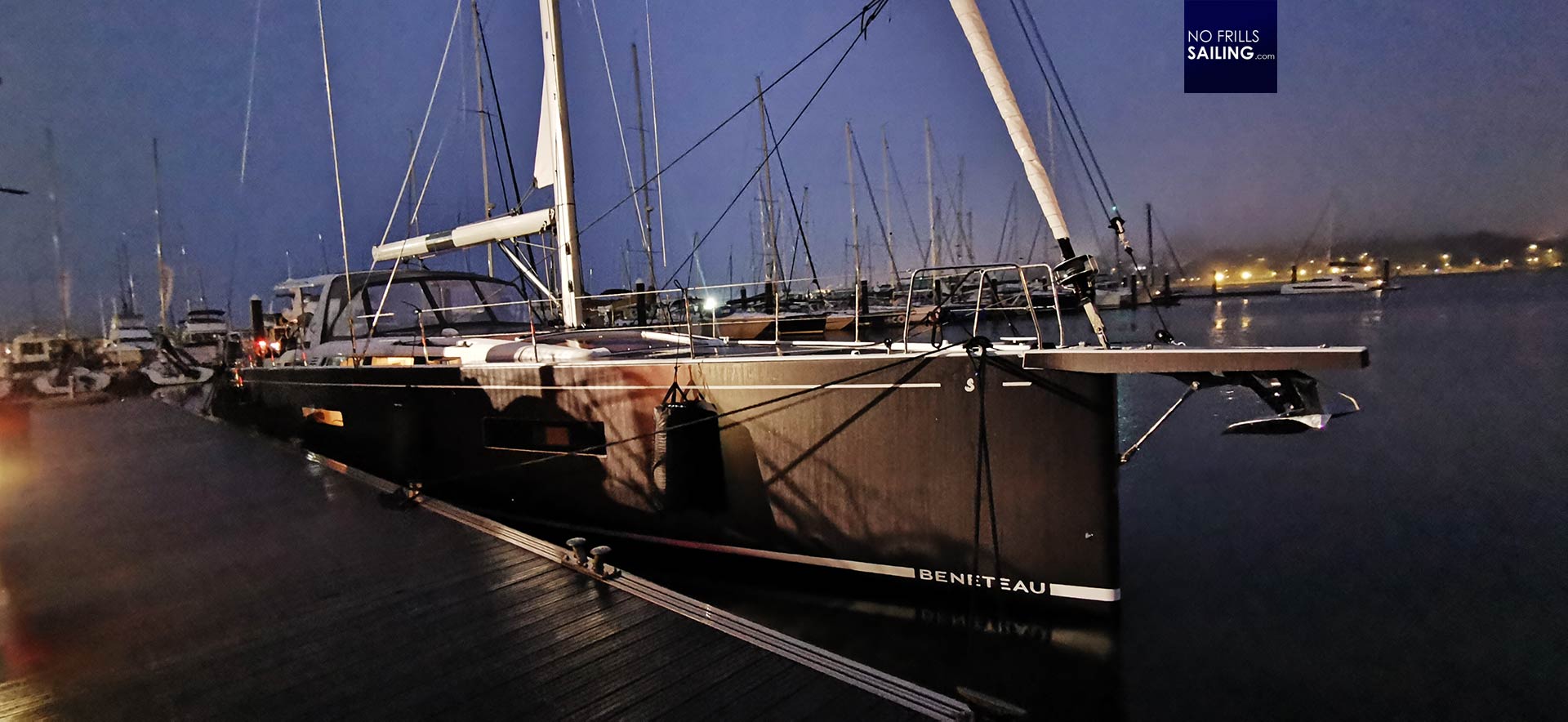
After negotiating the dark waterway of Porto, SOSIMA finally berthed at 0700 in the morning. That was it, at least for me: My 550 nautical miles delivery trip ended, surprisingly very abrupt. Without taking any more sleep, we just had a nice coffee and I started to pack my stuff. Lucky me, I was able to secure a home flight ticket for 10 o´clock. Time to say Goodbye …
Creating memories
So, what have I learned? Well, every single mile sailing on a yacht is a chance to improve, a chance to learn. Again, the Bay of Biscay showed a face I hadn´t met before, again, this notorious sailing area presented some challenges and surprises. Also, sailing a yacht as big as the Oceanis Yacht 60 posed the chance to accumulate very valuable insights for me, seakind sailing of this hull, sails trim of Hydranet furling sails and – most surprisingly – I´d say that this time 90 per cent of sailed miles had been done upwind close-hauled. But that isn´t the most important thing.
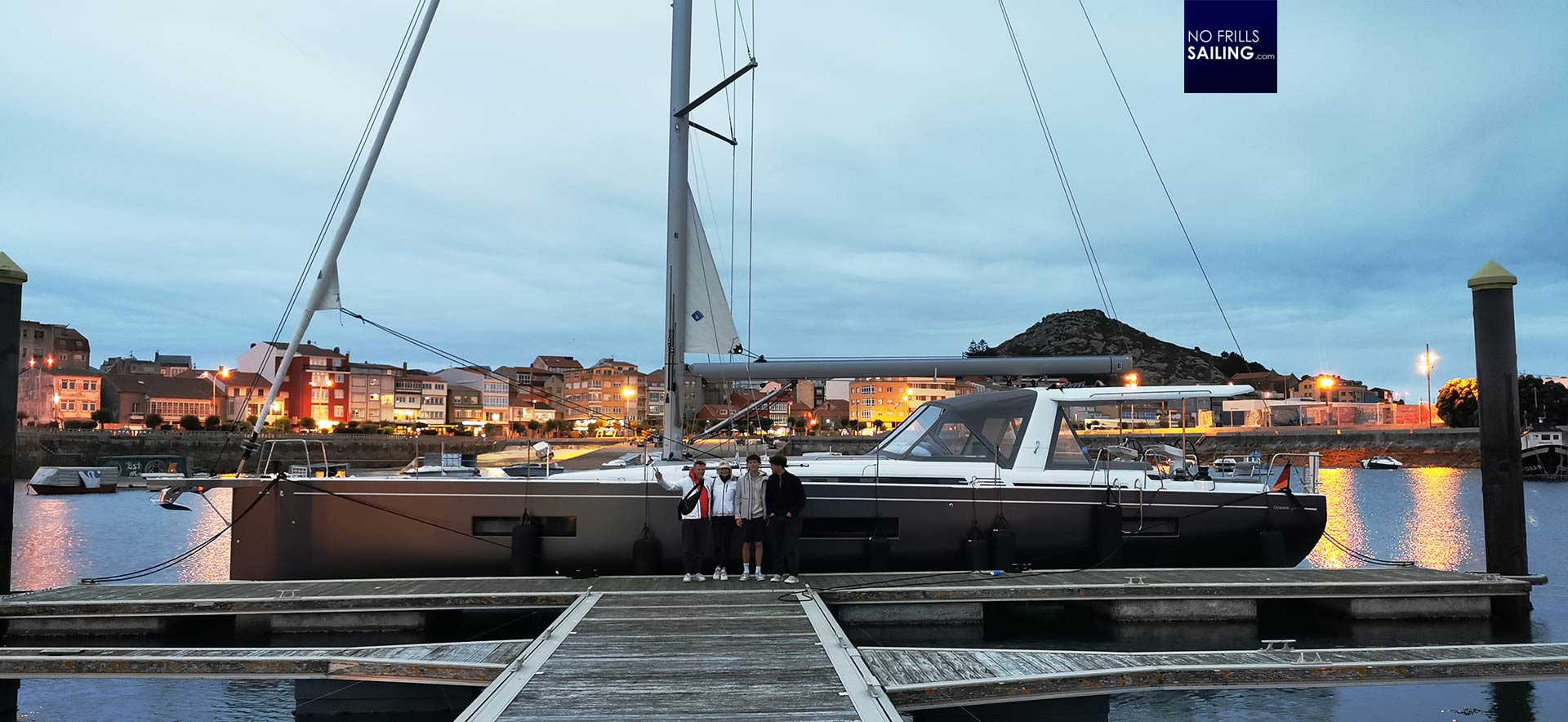
Looking at the picture above, which I´ve taken from the owner´s family in front of their SOSIMA in Muxia, I realized even more what sailing and owning a boat is all about. Remembering my interview with Beneteau boss Jean Francois Lair during last Boot Duesseldorf boat show. He said, for him, sailing is all about creating memories. On my flight back, I thought about that sentence very intensively. And he is right: Creating memories for you, your partner and most importantly for your children, this is the thing. A yacht, no matter the size, no matter the price, is just a vehicle, a base, a mean of transportation, to bring you and your family to places which are exciting – and a tool to create memories which are unforgettable, welding together your family.
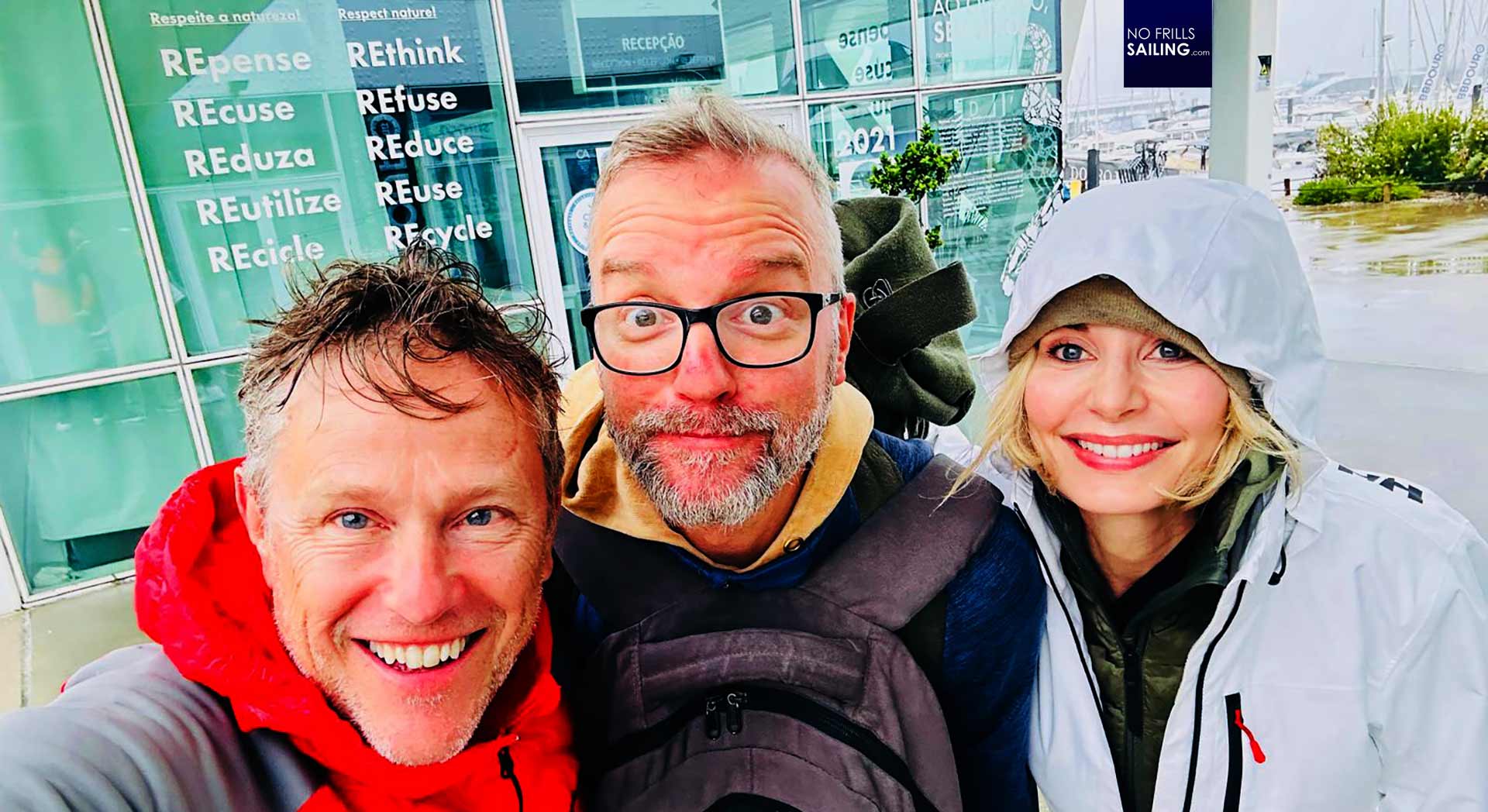
And so I say Goodbye to the good crew of SOSIMA: It was a pleasure and an honor to be your delivery skipper on this amazing shakedown cruise and maiden voyage! I wish more of my clients and customers would choose to sail their boats from the shipyard to their new homeports instead of road truck transport – it is the most intensive and profoundly changing way to embrace the new boat into one´s life. Fair winds, SOSIMA, always – and many, many, many thousands of miles happy sailing to you and your fine family!
You may also read these related articles:
The other way ´round: Sailing from Porto through the Bay of Biscay
Lisbon to Madeira: Taking on the mighty Atlantic Ocean
